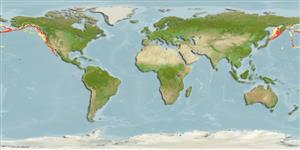分类 / Names
俗名 | 同种异名 | Catalog of Fishes(属, 种) | ITIS | CoL | WoRMS | Cloffa
Elasmobranchii
板鳃亚纲 (鲨鱼与 鱼) (sharks and rays) >
Rajiformes (Skates and rays) >
Arhynchobatidae (Softnose skates)
Etymology: Bathyraja: Greek, bathys = deep + Latin, raja, -ae = a ray (Raja sp) (Ref. 45335).
More on author: Gilbert.
Environment: milieu / climate zone / depth range / distribution range
生态学
海洋 深海底的; 深度上下限 213 - 2550 m (Ref. 80796). 深水域; 63°N - 22°N, 144°E - 106°W
Northeastern Pacific: from the Bering Sea, south to gthe Gulf of California, Mexico, and to the west to the Sea of Okhotsk.
北太平洋: 白令海到墨西哥的下加利福尼亞北部。
大小 / 重量 / 年龄
Maturity: Lm ? range ? - ? cm
Max length : 91.0 cm TL 雄鱼/尚未辨别雌雄; (Ref. 87722); 89.0 cm TL (female); 最大体重: 5.0 kg (Ref. 87722); 最大年龄: 20 年 (Ref. 87722)
简单描述
检索表 | 型态特徵 | 形态测量图
This moderately sized skates (91.0 cm TL) with disc length (28.7-56.7% TL) are distinguished by the following: pectorals broadly rounded, head length short (15.0-24.1% TL), preorbital length short (9.0-13.5% TL) are also distinguished by having the following: claspers short, tips relatively rounded, with large pseudosiphon and a strong, short pseudorhipidion, not reaching the tip, V-shaped cleft, projection absent; teeth in 27-36 rows on upper jaw and in 26-36 rows on lower jaw; pectoral fin radials 81; pelvics 23; total vertebrae 109; dorsal surface is covered with rough prickles, prickles on tail are larger and more robust; thorns on dorsal surface, mature males with alar thorns, no malar thorns, middorsal thorns weak or absent (0-1); nuchal thorns small or obsolete (0-3); tail thorns moderate (21-30); interdorsal thorns are small to occasionally absent (0-1). Colouration: dorsal dark purple, brown, or grey, spiracles occasionally pale, ventral coloration a lighter grey than dorsal surface, often with white blotching on mouth, gills, cloaca, and scattered across the body (Ref. 126515).
Inhabits deeper waters than hardnose skates and reported to prefer medium to cold temperatures and low oxygen environments compared to its congeners. It is found over a wide range of substrates, from fine sediment to rocky environments. Feeds mostly on benthic organisms, including annelids, shrimps, crabs, and fishes, with adults preferring fishes, whereas juveniles consume mostly invertebrates (Ref. 126515). Oviparous. Distinct pairing with embrace. Young may tend to follow large objects, such as their mother (Ref. 205). Reported size at maturity for males 74 cm TL and for females 80 cm TL with males growing to at least 90 cm TL and females at least 89 cm TL; with size at birth 9-16 cm TL. Maximum age reported estimated to be 20 years for males and 17 years for females. Egg cases small in size (6.2-7.8 cm TL), colour dark brown and becoming light golden brown on keels, which are smooth and plush-like when touched. Egg cases with long, slender horns at each corner, curving inwardly and slightly overlap at their tips with a distinct crossbar originating midway along the posterior horns in some specimens (Ref. 126515).
卵生的。 明显的成对出现。 幼鱼可能倾向跟随大的个体, 例如他们的母亲.(参考文献 205) 卵为长方形鞘囊具有僵硬的触角沈积在沙滩或泥滩的角落.(参考文献 205) 卵鞘是 7.5 公分长与 6.1 公分宽的.(参考文献 41249)
Life cycle and mating behavior
成熟度 | 繁殖 | 产卵场 | 卵 | 孕卵数 | 仔鱼
Oviparous, paired eggs are laid. Embryos feed solely on yolk (Ref. 50449). Distinct pairing with embrace. Young may tend to follow large objects, such as their mother (Ref. 205).北太平洋: 白令海到墨西哥的下加利福尼亞北部。
Knuckey, J.D.S. and D.A. Ebert, 2022. A taxonomic revision of Northeast Pacific softnose skates (Rajiformes: Arhynchobatidae: Bathyraja Ishiyama). Zootaxa 5142(1):1-89. (Ref. 126515)
世界自然保护联盟红皮书 (Ref. 130435: Version 2024-1)
人类利用
工具
特别资料
下载 XML
网络资源
Estimates based on models
Preferred temperature (Ref.
123201): 2.2 - 5.2, mean 3 °C (based on 183 cells).
Phylogenetic diversity index (Ref.
82804): PD
50 = 0.5000 [Uniqueness, from 0.5 = low to 2.0 = high].
Bayesian length-weight: a=0.00447 (0.00277 - 0.00721), b=3.05 (2.91 - 3.19), in cm total length, based on LWR estimates for this species & Genus-body shape (Ref.
93245).
营养阶层 (Ref.
69278): 4.0 ±0.7 se; based on size and trophs of closest relatives
Generation time: 12.2 ( na - na) years. Estimated as median ln(3)/K based on 2
growth studies.
回复力 (Ref.
120179): 低的, 最小族群倍增时间4.5 - 14 年 (Fec assumed to be <100).
Fishing Vulnerability (Ref.
59153): High vulnerability (57 of 100).
Nutrients (Ref.
124155): Calcium = 6.64 [1.31, 32.87] mg/100g; Iron = 0.293 [0.070, 0.933] mg/100g; Protein = 15.7 [13.1, 18.2] %; Omega3 = 0.579 [0.189, 2.290] g/100g; Selenium = 16.2 [4.6, 50.1] μg/100g; VitaminA = 9.31 [2.07, 42.12] μg/100g; Zinc = 0.29 [0.15, 0.54] mg/100g (wet weight);
